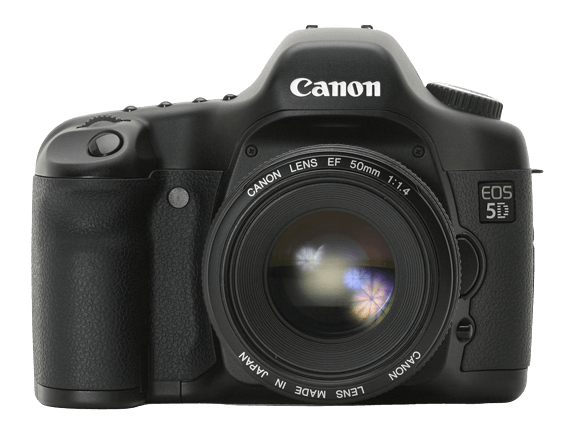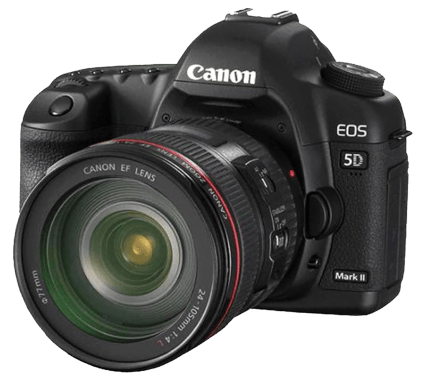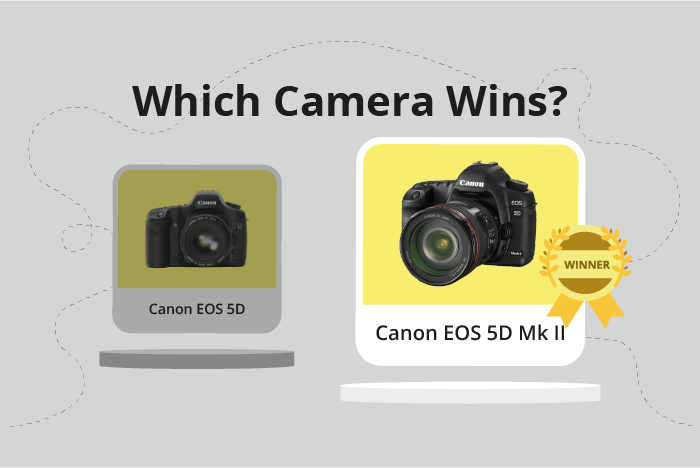Canon EOS 5D vs EOS 5D Mark II Comparison
Canon EOS 5D

Canon EOS 5D Mark II

The Canon EOS 5D Mark II outperforms the Canon EOS 5D with a score of 58/100 compared to 40/100. Both cameras are DSLRs and share similar dimensions, with sizes of 152 x 113 x 75mm for the 5D and 152 x 114 x 75mm for the 5D Mark II. The 5D Mark II, released in 2008, is an improved version of the 5D which was launched in 2005. The 5D Mark II costs slightly more, with a launch price of $2199 compared to the 5D’s $2000.
The 5D Mark II’s higher score indicates its superior performance with features like a lighter weight of 850g, making it easier to handle than the 5D which weighs 895g. However, the 5D may still be preferred by some due to its lower price. Ultimately, the Canon EOS 5D Mark II offers better specs, making it the winner in this comparison.
Canon EOS 5D vs EOS 5D Mark II Overview and Optics
The Canon EOS 5D Mark II is the winner in optics with a score of 59/100, while the Canon EOS 5D trails behind with a score of 46/100. Both cameras share some similarities in their specifications, such as the CMOS sensor type, full-frame sensor size, Canon EF lens mount, and lack of image stabilization.
The 5D Mark II’s superiority is evident in its higher megapixel count of 21, compared to the 5D’s 12.7. This results in better image resolution and detail. The 5D Mark II also has a more advanced processor – the Digic 4, compared to the 5D’s Digic II. This allows for faster processing and improved image quality. The 5D Mark II’s shooting speed is slightly higher at 3.9, compared to the 5D’s 3, which may be beneficial for capturing fast-moving subjects. Furthermore, the 5D Mark II has a higher DXOMARK sensor score of 79, compared to the 5D’s 71, indicating better overall image quality and performance.
On the other hand, the Canon EOS 5D does not have any clear advantages in optics over the 5D Mark II. The lower score of 46/100 reflects its inferior performance in terms of image resolution, processor, and sensor quality.
Taking these factors into account, the Canon EOS 5D Mark II is the clear winner in terms of optics. Its higher megapixel count, advanced processor, and superior sensor quality make it a better choice for those seeking improved image quality and performance. The Canon EOS 5D, with its lower score, is not as competitive in this aspect, and may be more suitable for those prioritizing other features or seeking a lower-cost option.
Canon EOS 5D vs EOS 5D Mark II Video Performance
When it comes to video capabilities, the Canon EOS 5D does not have any video functionality. On the other hand, the Canon EOS 5D Mark II offers video recording, with a video score of 43 out of 100.
The Canon EOS 5D Mark II records Full HD video, providing a maximum resolution of 1920 x 1080. This camera allows users to capture video at a maximum frame rate of 30 frames per second. However, it is worth noting that the Canon EOS 5D Mark II does not have built-in time-lapse functionality.
Taking into account the video capabilities, the Canon EOS 5D Mark II is the clear choice for users who require video recording features. The lack of video functionality in the Canon EOS 5D may not be suitable for those looking to capture both still images and video content.
Canon EOS 5D vs EOS 5D Mark II Features and Benefits
The Canon EOS 5D Mark II surpasses the Canon EOS 5D with a feature score of 54/100, while the 5D only reaches 30/100. Both cameras share some common specifications, including the absence of a touchscreen, flip screen, GPS, and Bluetooth. They both, however, provide Wi-Fi connectivity.
The 5D Mark II offers a larger screen size of 3 inches, compared to the 2.5-inch screen on the 5D. Moreover, the 5D Mark II boasts a significantly higher screen resolution of 920,000 dots, providing a clearer and more detailed display than the 5D’s 230,000 dots. These improvements in screen size and resolution contribute to the 5D Mark II’s higher feature score.
As for the 5D, it does not possess any specific advantages over the 5D Mark II in terms of features, as they both lack the same specifications. The only difference is the lower feature score, which puts the 5D at a disadvantage when compared to the 5D Mark II.
Considering the larger screen size and higher resolution of the 5D Mark II, it is the superior camera in terms of features. The Canon EOS 5D, with its smaller screen size and lower resolution, fails to match up to the higher standards set by the 5D Mark II. Thus, the Canon EOS 5D Mark II is the clear winner in this comparison, offering better display quality and an overall improved user experience.
Canon EOS 5D vs EOS 5D Mark II Storage and Battery
The Canon EOS 5D Mark II wins in the storage and battery category with a score of 71/100, while the Canon EOS 5D scores 24/100. Both cameras share some specifications, such as accepting Compact Flash (Type I or II) memory cards and lacking USB charging capabilities.
The 5D Mark II outperforms the 5D in several aspects. It has two memory card slots, allowing for more storage and flexibility, and accepts additional card types like UDMA and Microdrive. The Mark II also boasts a longer battery life, capable of capturing 850 shots with its LP-E6 battery, compared to the 5D’s 400 shots using a BP-511A battery.
Though the Canon EOS 5D falls short in this comparison, it still provides a decent battery life and memory card compatibility for casual photographers. However, the Canon EOS 5D Mark II clearly stands out as the superior choice in terms of storage and battery life, making it a more reliable option for professional photography and extended shooting sessions.
Canon EOS 5D vs EOS 5D Mark II – Our Verdict
Are you still undecided about which camera is right for you? Have a look at these popular comparisons that feature the Canon EOS 5D or the Canon EOS 5D Mark II:

